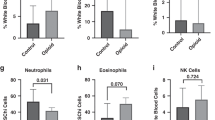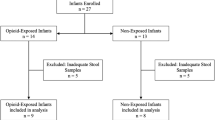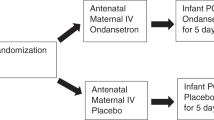Abstract
Objective:
Opioids and clonidine, used in for sedation, analgesia and control of opioid withdrawal in neonates, directly or indirectly activate opioid receptors (OPRs) expressed in immune cells. Therefore, our objective is to study how clinically relevant concentrations of different opioids and clonidine change cytokine levels in cultured whole blood from preterm and full-term infants.
Study Design:
Using blood from preterm (⩽ 30 weeks gestational age (GA), n=7) and full-term (⩾37 weeks GA, n=19) infants, we investigated the changes in cytokine profile (IL-1β, IL-6, IL-8, IL-10, IL-12p70 and TNF-α), cyclic adenosine monophosphate (cAMP) levels and μ-, δ- and κ- opioid receptor (OPR) gene and protein expression, following in-vitro exposure to morphine, methadone, fentanyl or clonidine at increasing concentrations ranging from 0 to 1 mM.
Result:
Following lipopolysaccharide activation, IL-10 levels were 146-fold greater in cultured blood from full-term than from preterm infants. Morphine and methadone, but not fentanyl, at >10–5 M decreased all tested cytokines except IL-8. In contrast, clonidine at <10–9 M increased IL-6, while at >10–5 M increased IL-1β and decreased TNF-α levels. All cytokine changes followed the same patterns in preterm and full-term infant cultured blood and matched increases in cAMP levels. All three μ-, δ- and κ-OPR genes were expressed in mononuclear cells (MNC) from preterm and full-term infants. Morphine, methadone and clonidine, but not fentanyl, at >10–5M decreased the expression of μ-OPR, but not δ- or κ-OPRs.
Conclusion:
Generalized cytokine suppression along with downregulation of μ-OPR expression observed in neonatal MNC exposed to morphine and methadone at clinically relevant concentrations contrast with the modest effects observed with fentanyl and clonidine. Therefore, we speculate that fentanyl and clonidine may be safer therapeutic choices for sedation and control of opioid withdrawal and pain in neonates.
This is a preview of subscription content, access via your institution
Access options
Subscribe to this journal
Receive 12 print issues and online access
$259.00 per year
only $21.58 per issue
Buy this article
- Purchase on Springer Link
- Instant access to full article PDF
Prices may be subject to local taxes which are calculated during checkout




Similar content being viewed by others
References
Mikawa K, Nishina K, Maekawa N, Obara H . Oral clonidine premedication reduces postoperative pain in children. Anesth Analg 1996; 82: 225–230.
Nishina K, Mikawa K, Shiga M, Maekawa N, Obara H . Oral clonidine premedication reduces minimum alveolar concentration of sevoflurane for tracheal intubation in children. Anesthesiology 1997; 87: 1324–1327.
Sumiya K, Homma M, Watanabe M, Baba Y, Inomata S, Kihara S et al. Sedation and plasma concentration of clonidine hydrochloride for pre-anesthetic medication in pediatric surgery. Biol Pharm Bull 2003; 26: 421–423.
Agthe AG, Kim GR, Mathias KB, Hendrix CW, Chavez-Valdez R, Jansson L et al. Clonidine as an adjunct therapy to opioids for neonatal abstinence syndrome: a randomized, controlled trial. Pediatrics 2009; 123: e849–e856.
Hocker J, Bohm R, Meybohm P, Gruenewald M, Renner J, Ohnesorge H et al. Interaction of morphine but not fentanyl with cerebral alpha2-adrenoceptors in alpha2-adrenoceptor knockout mice. J Pharm Pharmacol 2009; 61: 901–910.
Gyires K, Ronai AZ, Mullner K, Furst S . Intracerebroventricular injection of clonidine releases beta-endorphin to induce mucosal protection in the rat. Neuropharmacology 2000; 39: 961–968.
Maes M, Lin A, Kenis G, Egyed B, Bosmans E . The effects of noradrenaline and alpha-2 adrenoceptor agents on the production of monocytic products. Psychiatry Res 2000; 96: 245–253.
West JP, Dykstra LA, Lysle DT . Immunomodulatory effects of morphine withdrawal in the rat are time dependent and reversible by clonidine. Psychopharmacology (Berl) 1999; 146: 320–327.
Bidlack JM . Detection and function of opioid receptors on cells from the immune system. Clin Diagn Lab Immunol 2000; 7: 719–723.
Chang SL, Wu GD, Patel NA, Vidal EL, Fiala M . The effects of interaction between morphine and interleukin-1 on the immune response. Adv Exp Med Biol 1998; 437: 67–72.
Gaveriaux-Ruff C, Matthes HW, Peluso J, Kieffer BL . Abolition of morphine-immunosuppression in mice lacking the mu-opioid receptor gene. Proc Natl Acad Sci USA 1998; 95: 6326–6330.
Makarenkova VP, Esche C, Kost NV, Shurin GV, Rabin BS, Zozulya AA et al. Identification of delta- and mu-type opioid receptors on human and murine dendritic cells. J Neuroimmunol 2001; 117: 68–77.
McCarthy L, Szabo I, Nitsche JF, Pintar JE, Rogers TJ . Expression of functional mu-opioid receptors during T cell development. J Neuroimmunol 2001; 114: 173–180.
Sibinga NE, Goldstein A . Opioid peptides and opioid receptors in cells of the immune system. Annu Rev Immunol 1988; 6: 219–249.
Roy S, Ninkovic J, Banerjee S, Charboneau RG, Das S, Dutta R et al. Opioid drug abuse and modulation of immune function: consequences in the susceptibility to opportunistic infections. J Neuroimmune Pharmacol 2011; 6: 442––4465.
Wang J, Barke RA, Ma J, Charboneau R, Roy S . Opiate abuse, innate immunity, and bacterial infectious diseases. Arch Immunol Ther Exp (Warsz) 2008; 56: 299–309.
Gasparoni A, Ciardelli L, Avanzini A, Castellazzi AM, Carini R, Rondini G et al. Age-related changes in intracellular TH1/TH2 cytokine production, immunoproliferative T lymphocyte response and natural killer cell activity in newborns, children and adults. Biol Neonate 2003; 84: 297–303.
Sadeghi K, Berger A, Langgartner M, Prusa AR, Hayde M, Herkner K et al. Immaturity of infection control in preterm and term newborns is associated with impaired toll-like receptor signaling. J Infect Dis 2007; 195: 296–302.
Strunk T, Richmond P, Simmer K, Currie A, Levy O, Burgner D . Neonatal immune responses to coagulase-negative staphylococci. Curr Opin Infect Dis 2007; 20: 370–375.
Strunk T, Currie A, Richmond P, Simmer K, Burgner D . Innate immunity in human newborn infants: prematurity means more than immaturity. J Matern Fetal Neonatal Med 2011; 24: 25–31.
Forster-Waldl E, Sadeghi K, Tamandl D, Gerhold B, Hallwirth U, Rohrmeister K et al. Monocyte toll-like receptor 4 expression and LPS-induced cytokine production increase during gestational aging. Pediatr Res 2005; 58: 121–124.
Hallwirth U, Pomberger G, Pollak A, Roth E, Spittler A . Monocyte switch in neonates: high phagocytic capacity and low HLA-DR expression in VLBWI are inverted during gestational aging. Pediatr Allergy Immunol 2004; 15: 513–516.
Jones CA, Holloway JA, Warner JO . Phenotype of fetal monocytes and B lymphocytes during the third trimester of pregnancy. J Reprod Immunol 2002; 56: 45–60.
Marodi L . Innate cellular immune responses in newborns. Clin Immunol 2006; 118: 137–144.
Chao CC, Molitor TW, Close K, Hu S, Peterson PK . Morphine inhibits the release of tumor necrosis factor in human peripheral blood mononuclear cell cultures. Int J Immunopharmacol 1993; 15: 447–453.
Peterson PK, Sharp B, Gekker G, Brummitt C, Keane WF . Opioid-mediated suppression of interferon-gamma production by cultured peripheral blood mononuclear cells. J Clin Invest 1987; 80: 824–831.
Roy S, Cain KJ, Chapin RB, Charboneau RG, Barke RA . Morphine modulates NF kappa B activation in macrophages. Biochem Biophys Res Commun 1998; 245: 392–396.
Taenzer AH, Groom R, Quinn RD . Fentanyl plasma levels after modified ultrafiltration in infant heart surgery. J Extra Corpor Technol 2005; 37: 369–372.
Wolfs TG, Derikx JP, Hodin CM, Vanderlocht J, Driessen A, de Bruine AP et al. Localization of the lipopolysaccharide recognition complex in the human healthy and inflamed premature and adult gut. Inflamm Bowel Dis 2010; 16: 68–75.
Bianchi M, Maggi R, Pimpinelli F, Rubino T, Parolaro D, Poli V et al. Presence of a reduced opioid response in interleukin-6 knock out mice. Eur J Neurosci 1999; 11: 1501–1507.
Borner C, Kraus J, Schroder H, Ammer H, Hollt V . Transcriptional regulation of the human mu-opioid receptor gene by interleukin-6. Mol Pharmacol 2004; 66: 1719–1726.
Kraus J, Borner C, Giannini E, Hollt V . The role of nuclear factor kappaB in tumor necrosis factor-regulated transcription of the human mu-opioid receptor gene. Mol Pharmacol 2003; 64: 876–884.
Philippe D, Chakass D, Thuru X, Zerbib P, Tsicopoulos A, Geboes K et al. Mu opioid receptor expression is increased in inflammatory bowel diseases: implications for homeostatic intestinal inflammation. Gut 2006; 55: 815–823.
Vidal EL, Patel NA, Wu G, Fiala M, Chang SL . Interleukin-1 induces the expression of mu opioid receptors in endothelial cells. Immunopharmacology 1998; 38: 261–266.
Novak-Jankovic V, Paver-Ercirc,en V, Bovill JG, Ihan A, Osredkar J . Effect of epidural and intravenous clonidine on the neuro-endocrine and immune stress response in patients undergoing lung surgery. Eur J Anaesthesiol 2000; 17: 50–56.
Persec J, Persec Z, Bukovic D, Merc V, Pavelic J, Zupic T . Preoperative clonidine or levobupivacaine—effect on systemic inflammatory stress response. Coll Antropol 2009; 33: 573–577.
von Dossow V, Baehr N, Moshirzadeh M, von Heymann C, Braun JP, Hein OV et al. Clonidine attenuated early proinflammatory response in T-cell subsets after cardiac surgery. Anesth Analg 2006; 103: 809–814.
Xu B, Makris A, Thornton C, Ogle R, Horvath JS, Hennessy A . Antihypertensive drugs clonidine, diazoxide, hydralazine and furosemide regulate the production of cytokines by placentas and peripheral blood mononuclear cells in normal pregnancy. J Hypertens 2006; 24: 915–922.
Connor TJ, Kelly JP, Leonard BE . An assessment of the acute effects of the serotonin releasers methylenedioxymethamphetamine, methylenedioxyamphetamine and fenfluramine on immunity in rats. Immunopharmacology 2000; 46: 223–235.
Geiduschek JM, Lynn AM, Bratton SL, Sanders JC, Levy FH, Haberkern CM et al. Morphine pharmacokinetics during continuous infusion of morphine sulfate for infants receiving extracorporeal membrane oxygenation. Crit Care Med 1997; 25: 360–364.
Kuschel CA, Austerberry L, Cornwell M, Couch R, Rowley RS . Can methadone concentrations predict the severity of withdrawal in infants at risk of neonatal abstinence syndrome? Arch Dis Child Fetal Neonatal Ed 2004; 89: F390–F393.
Kussman BD, Zurakowski D, Sullivan L, McGowan FX, Davis PJ, Laussen PC . Evaluation of plasma fentanyl concentrations in infants during cardiopulmonary bypass with low-volume circuits. J Cardiothorac Vasc Anesth 2005; 19: 316–321.
Xie HG, Cao YJ, Gauda EB, Agthe AG, Hendrix CW, Lee H . Clonidine clearance matures rapidly during the early postnatal period: a population pharmacokinetic analysis in newborns with neonatal abstinence syndrome. J Clin Pharmacol 2011; 51: 502–511.
Bouwmeester NJ, Anderson BJ, Tibboel D, Holford NH . Developmental pharmacokinetics of morphine and its metabolites in neonates, infants and young children. Br J Anaesth 2004; 92: 208–217.
Faggiano F, Vigna-Taglianti F, Versino E, Lemma P . Methadone maintenance at different dosages for opioid dependence. Cochrane Database Syst Rev 2003 CD002208..
Chavez-Valdez R, Wills-Karp M, Ahlawat R, Cristofalo EA, Nathan A, Gauda EB . Caffeine modulates TNF-alpha production by cord blood monocytes: the role of adenosine receptors. Pediatr Res 2009; 65: 203–208.
Horrigan LA, Kelly JP, Connor TJ . Caffeine suppresses TNF-alpha production via activation of the cyclic AMP/protein kinase A pathway. Int Immunopharmacol 2004; 4: 1409–1417.
Bradford MM . A rapid and sensitive method for the quantitation of microgram quantities of protein utilizing the principle of protein-dye binding. Anal Biochem 1976; 72: 248–254.
Pfaffl MW, Horgan GW, Dempfle L . Relative expression software tool (REST) for group-wise comparison and statistical analysis of relative expression results in real-time PCR. Nucleic Acids Res 2002; 30: e36.
Trescot AM, Datta S, Lee M, Hansen H . Opioid pharmacology. Pain physician 2008; 11: S133–S153.
Schreiber S, Nikolaus S, Hampe J . Activation of nuclear factor kappa B inflammatory bowel disease. Gut 1998; 42: 477–484.
Bonnet MP, Beloeil H, Benhamou D, Mazoit JX, Asehnoune K . The mu opioid receptor mediates morphine-induced tumor necrosis factor and interleukin-6 inhibition in toll-like receptor 2-stimulated monocytes. Anesth Analg 2008; 106: 1142–1149 table of contents.
Meuser T, Giesecke T, Gabriel A, Horsch M, Sabatowski R, Hescheler J et al. Mu-opioid receptor mRNA regulation during morphine tolerance in the rat peripheral nervous system. Anesth Analg 2003; 97: 1458–1463.
Zhu ZP, Badisa RB, Palm DE, Goodman CB . Regulation of rat MOR-1 gene expression after chronic intracerebroventricular administration of morphine. Mol Med Report 2012; 5: 513–516.
Chen JC, Smith ER, Cahill M, Cohen R, Fishman JB . The opioid receptor binding of dezocine, morphine, fentanyl, butorphanol and nalbuphine. Life Sci 1993; 52: 389–396.
Chao CC, Gekker G, Hu S, Sheng WS, Portoghese PS, Peterson PK . Upregulation of HIV-1 expression in cocultures of chronically infected promonocytes and human brain cells by dynorphin. Biochem Pharmacol 1995; 50: 715–722.
Kaneider NC, Dunzendorfer S, Wiedermann CJ . Heparan sulfate proteoglycans are involved in opiate receptor-mediated cell migration. Biochemistry 2004; 43: 237–244.
Parkhill AL, Bidlack JM . Reduction of lipopolysaccharide-induced interleukin-6 production by the kappa opioid U50,488 in a mouse monocyte-like cell line. Int Immunopharmacol 2006; 6: 1013–1019.
Sharp BM, Li MD, Matta SG, McAllen K, Shahabi NA . Expression of delta opioid receptors and transcripts by splenic T cells. Ann NY Acad Sci 2000; 917: 764–770.
Oh WS . Effect of fentanyl on TNF-alpha and IL-1beta levels during global ischemia/reperfusion in rats. Int J Tissue React 2002; 24: 11–21.
McBride WT, Armstrong MA, McMurray TJ . An investigation of the effects of heparin, low molecular weight heparin, protamine, and fentanyl on the balance of pro- and anti-inflammatory cytokines in in-vitro monocyte cultures. Anaesthesia 1996; 51: 634–640.
Rao Y, Wang YL, Li JG, Ke JJ . Effects of morphine and fentanyl on tumor necrosis factor-alpha and interleukin-6 concentrations in human whole blood in vitro. Chin Med J 2004; 117: 303–304.
Martucci C, Panerai AE, Sacerdote P . Chronic fentanyl or buprenorphine infusion in the mouse: similar analgesic profile but different effects on immune responses. Pain 2004; 110: 385–392.
Kaye AD, Banister RE, Hoover JM, Baluch AR, Jacobs S, Shah RV . Chronic pain and ultrarapid opioid detoxification. Pain Pract 2005; 5: 33–42.
Mosqueda-Garcia R, Kunos G . Opiate receptors and the endorphin-mediated cardiovascular effects of clonidine in rats: evidence for hypertension-induced mu-subtype to delta-subtype changes. Proc Natl Acad Sci USA 1987; 84: 8637–8641.
Eap CB, Buclin T, Baumann P . Interindividual variability of the clinical pharmacokinetics of methadone: implications for the treatment of opioid dependence. Clin Pharmacokinet 2002; 41: 1153–1193.
Felder C, Uehlinger C, Baumann P, Powell K, Eap CB . Oral and intravenous methadone use: some clinical and pharmacokinetic aspects. Drug Alcohol Depend 1999; 55: 137–143.
Acknowledgements
The authors gratefully acknowledge Dr Frances Northington and Dr Robert Bennett for their support; Mrs Debra Flock and Ms Ariel Mason for their administrative assistance and the obstetric team at Johns Hopkins Hospital for their kind support with patient enrollment. We are also indebted to our patients and their families for their willingness to participate in this study. This study was financially supported by the National Institute for Drug Abuse (NIDA) R25DA021630 (EBG).
Author information
Authors and Affiliations
Corresponding author
Ethics declarations
Competing interests
The authors declare no conflict of interest.
Rights and permissions
About this article
Cite this article
Chavez-Valdez, R., Kovell, L., Ahlawat, R. et al. Opioids and clonidine modulate cytokine production and opioid receptor expression in neonatal immune cells. J Perinatol 33, 374–382 (2013). https://doi.org/10.1038/jp.2012.124
Received:
Revised:
Accepted:
Published:
Issue Date:
DOI: https://doi.org/10.1038/jp.2012.124



